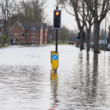Safety first
At the middle of the last century, a significant number of U.S. citizens lived on farms or in small communities of fewer than 5,000. Except on the East Coast, no real major cities (like those in Europe) existed. With the Industrial Revolution, people left their farms to become a new type of citizen: the urban dweller.
The concentration of increasingly large numbers of people created two public safety problems: crime and fire. Consequently, police and fire departments became more and more important, and the tasks of fighting fire and crime evolved from the work of individual volunteers to centralized agencies operating under the auspices of the local governments. Once those centralized agencies were established, change within them was rapid.
The growth of the fire service
The growth of populations and resulting crowding created conditions ripe for fire. Many of the major cities that developed during that era experienced horrendous conflagrations. In the last quarter of the century, one of the most famous urban fires occurred in Chicago, which burned nearly to the ground in October of 1871. That same day, a Peshtigo, Wis., forest fire claimed thousands of lives. Boston was hit se verely by fire in 1872, and, in 1904, Baltimore was partially destroyed. It was inevitable that the fire service would become more important to modern cities.
“After the shock of the fires wore off, the people in (these) cities welcomed the destruction as an opportunity to ‘make things better than before,'” writes Christine Meisner Rosen in her book, “The Limits of Power: Great Fires and the Process of City Growth in America.” The history of the last 100 years has been one of constant struggle between conflicting needs: first, the need to respond and deal with growth in the urban setting; and second, the need to create an environment where that growth can be achieved with minimal threat to the life and property of a city’s population.
As cities have grown, so has the fire service. Cities have changed from the “walking towns” of the previous century to the physically challenging environs of today. History notes that, after every fire, there was an attempt to make things better. (The phenomenon even has a name -“the catastrophic theory of reform.”)
Each catastrophe has led to the creation of new rules and regulations, or improvements in technology or methodology. For example, the devastating fires of the last century resulted in two major actions that had an effect that lasted almost 50 years. The first was the creation of an evaluation system, called the “grading schedule,” for measuring communities’ fire defenses. The grading schedule was a major influence on the design and staffing of urban fire services for more than half a century.
The second action was the creation of more formal and structured fire department operations, including not just fire suppression, but also fire prevention and code enforcement. Full-time fire-fighting forces existed in almost all major cities before the close of the last century.
The evolution of the police service
The introduction of uniforms was one of the first critical changes in the urban police business. Once cities began outfitting their police, the entire system moved from being a ward-based constable-watch system to an actual department that operated day and night. “As a consequence,” notes Eric Monkkonen’s “Police in Urban America, 1860-1920,” “cities became more alike. Already tied together by an increasingly important urban network, the more efficient internal communications provided by the police also accelerated inter-city communication.”
Although uniforms made them look good, many of the police departments of the early part of this century suffered from the same corruption that affected city governments. “One turns from the history of our municipal development with the wish that most of its sordid story could be blotted out,” wrote Raymond Fosdick in “American Police Systems.”
The loudest critic of that corruption – and one of the leading voices for reform – was Berkeley, Calif., Police Chief August Vollmer. He authored a professional model of policing that “centered on a concept of the policeman as a skilled and dedicated crime fighter, rigorously trained to perform a difficult job; who was aggressive in using science and technology … and who was deeply involved in the community he served,” according to “Police Reform in the United States,” by Gene and Elaine Carte.
Professional policing, the Cartes wrote, arose in response to a number of social realities, including fear of crime, urban pressures and the increasing use of automobiles. Interestingly, to this day, those factors continue to affect the evolution of policing.
Changing equipment and training
For the first half of the century, most of the changes affecting both the police and the fire service involved equipment. In 1915, for instance, Joplin, Mo., Mayor High McIndoe wrote about his city’s efforts to make its police department “the equal of any in cities of our size,” by acquiring a fingerprint identification system, a police alarm and a signal system. Augusta, Ga., Fire Chief Frank Reynolds waxed poetic about the city’s new “double auto fire station,” as well as its combination hook and ladder truck. Marshalltown, Iowa’s fire chief noted that the department provided him with a motorcycle so that he could reach fires before the fire trucks – the better to plan the fire-fighting operation. (The invention of the internal combustion engine was critical to the development of the modern police and fire services.)
The 1920s were times of economic difficulty, so the acquisition of new and better equipment briefly took a backseat, and the focus of both the fire service and police departments turned to adequate training. As the country began to climb out of the Great Depression, the fire service’s focus shifted to building and fire code development and the planning process. The war years of the ’40s produced great leaps forward in technology, with the development of water fog nozzles, fire-fighting chemicals and two-way radios.
It was in the late 1920s that public safety wireless communications achieved its first major milestone. Many cities installed fire-alarm stations for citizens to report fires as well as telephone call-boxes from which patrol officers could communicate with commanders at headquarters. The only problem was the automobile. Stationary call boxes did not help when criminals raced away in a car.
William Rutledge put the Detroit Police Department on the air using a one-way AM radio developed by Batts. Cleveland, Indianapolis and a number of other cities and agencies quickly followed suit.
By the late 1920s, many cities had instituted extensive alarm systems for their police and fire departments. That meant that communications had to evolve since someone had to be able to answer the alarms and point police and firefighters in the right direction. Radio went two-way in the 1930s, with Indianapolis and Bayonne, N.J., installing two-way AM radio communications systems.
With the suburban sprawl that began in the ’50s, police and fire departments cropped up where none had existed before. That increased the importance of communication, and, by the 1960s, wireless communications devices were becoming standard-issue items for many public-safety agencies.
In the ’70s, high-rises, the idea of including paramedics in the fire service, and the increased emphasis upon fire service involvement in the field of hazardous materials presented challenges. Also in the ’70s, a report entitled “America Burning” made a number of recommendations and resulted in the creation of a United States Fire Administration, a National Fire Incident Reporting System and a National Fire Academy.
Public safety equipment continued to evolve with the introduction of newer and better cars, bullet-proof vests and better safety equipment. But, in the 1940s and 1950s, management and technology were becoming the most critical issues faced by the nation’s public safety providers.
A successful public safety response today – whether it be to a hurricane, freeway accident, fire or terrorist bombing – depends on the proper mix of people, training, equipment and communications. The latter has proven to be especially critical in both fire safety and police work, with the development of digital voice, mobile data and global positioning technology, as well as two-way text messaging and cellular telephones.
The emergence of 911
If communication in the field was important, the advent of a government-mandated, nationwide single emergency number – 911 – hastened the evolution of communications technology in dispatch centers. The first 911 call was made in 1968 in Haleyville, Ala., and, soon afterward, major metropolitan areas such as New York, Los Angeles, Baltimore and Chicago installed 911 call-taking centers.
Enhancements to 911 systems have continued ever since. Dispatchers now are provided automatic caller identification and address information, plus detailed information on location contents and even on residents’ special medical needs. (Today, some cities also have added 311 non-emergency capabilities.) Systems have become more integrated and compact, conserving limited space in dispatch service centers.
Computer technology ushered in the era of computer-aided dispatch systems, which automated the entire call-taking process and provided dispatchers access to a growing number of local, state and federal databases. Computer technology transformed radio units into sophisticated mobile and portable computing devices.
Mobile teleprinters made it possible to relay information from databases to responding personnel in their vehicles, and mobile data systems now feature complete color screens, removable keyboards, fast modems and Internet protocols. Public safety agencies use them for everything from dispatch and car-to-car communications to accessing databases right from the vehicle.
In the past decade, as developments in digital technology have made more features and capabilities available, agencies have begun to make the transition from analog to digital systems. Fully digital systems became possible when engineers discovered how to create high-quality digitized voice and combine it with data. Today, a digital radio can send and receive voice and data information using the same radio channels and infrastructure.
Looking ahead
Public safety agencies have come a long way from the days of the water bucket and the billy club. As criminals become more sophisticated, and fires become more likely to cause massive damage, the people who man the nation’s police and fire departments will continue to depend on evolving technologies in everything from cars to computers. Their jobs will never be as relatively threat-free as those of accountants and bowling alley managers, but continuing leaps forward in management and equipment can lessen the effects of the dangers to which they are exposed.
Ronny Coleman is a former fire chief for both Fullerton and San Clemente, Calif., and is a master instructor in the California Fire Service Training and Education System. He was the California state fire marshal from 1992 to 1999.



















